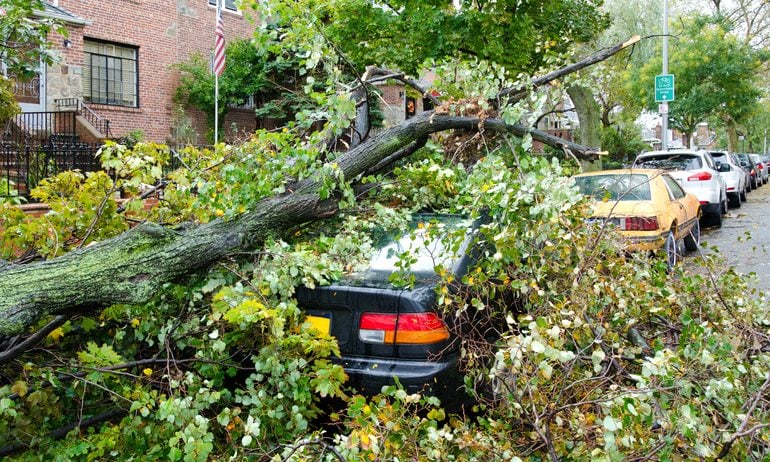Comprehensive vs. Collision Insurance: Know the Difference
Comprehensive and collision coverage isn't legally required, but it is useful for many drivers.

Many, or all, of the products featured on this page are from our advertising partners who compensate us when you take certain actions on our website or click to take an action on their website. However, this does not influence our evaluations. Our opinions are our own. Here is a list of our partners and here's how we make money.
Collision and comprehensive coverage are often sold as a package. Both pay to fix damage to your own car or replace it entirely — but they don’t cover injuries or damage to anyone else’s property.
What’s the difference between comprehensive and collision coverage?
Collision coverage pays for damage to your vehicle caused in a crash while comprehensive coverage covers damage caused by things other than a crash, like storms, animals or vandalism.
» MORE: What is auto insurance?
See what you could save on car insurance
Easily compare personalized rates to see how much switching car insurance could save you.
Comprehensive vs. collision insurance
Comprehensive and collision insurance are two of the most important types of car insurance to understand. They’re not legally required by any state, but they can pay for damage to your car in a variety of situations.
The main difference between comprehensive and collision insurance is the situations covered. Collision insurance pays for damage to your car if you hit an object or another vehicle, while comprehensive coverage pays for theft or damage from causes such as bad weather, fire or fallen trees. Some insurers require that you purchase collision and comprehensive insurance together, while other insurers may allow you to purchase these two types of coverage separately.
Collision insurance pays for:
Damage to your car in an accident you cause.
Damage to your car if you hit an object such as a fence or pole.
Damage to your car if someone else hits you. Another option in this case is to make a claim against the other driver's liability insurance.
Comprehensive insurance pays for:
The actual cash value of your car if it's stolen and not recovered, and damage from:
Weather such as tornadoes or hail.
Floods.
Fire.
Falling objects.
Explosions.
Crashes with an animal, such as striking a deer.
Riots and civil disturbances.
Vandalism.
For more in-depth information, see our guides to comprehensive insurance and collision insurance.
Do I need comprehensive and collision insurance?
You should consider buying comprehensive and collision insurance if:
You lease your vehicle or took out a loan to buy it. Your lender or leasing company probably requires you to carry collision and comprehensive coverage.
You couldn’t afford to replace or significantly repair your car if you crashed it or someone stole it.
Your area has a high incidence of car theft, vandalism, severe weather (like hail) or animal collisions.
About 80% of all U.S. drivers buy comprehensive coverage, and 76% buy collision, according to the Insurance Information Institute, which based its analysis on 2021 data from the National Association of Insurance Commissioners.
You probably don’t need comprehensive and collision insurance if your car is older and not worth a lot. That’s because the maximum payout you’ll get in a comprehensive or collision claim will be for the current market value of your car, minus the deductible.
If your car’s value is low, consider whether the potential payout would be worth the increase in premiums you’ll pay for the additional coverage. Remember, too, that the deductible amount will be subtracted from any claims check.
How much comprehensive and collision coverage cost
Adding comprehensive and collision coverage to your policy will increase your car insurance premium. That’s because you’ll be upgrading your coverage so it also pays for damage to your own vehicle, not just others’ injuries or property damage.
To get realistic comparisons, we compared June 2025 rates for minimum-coverage policies and policies with comprehensive, collision and higher liability limits. Together these three types of coverage are commonly considered “full coverage” car insurance.
Here are median monthly rates for a 35-year-old driver with good credit and no recent traffic violations or accidents.
Median monthly rate for a full coverage policy with comprehensive and collision coverage
$191
Median monthly rate for a minimum coverage policy without comprehensive or collision coverage
$52
Median rates for full and minimum coverage insurance can vary widely based on your personal characteristics and your state of residence. To see rates specific to different driver profiles, ages, locations and more, check out our analysis of average car insurance costs.
See what you could save on car insurance
Easily compare personalized rates to see how much switching car insurance could save you.
How to save on comprehensive and collision insurance
Average annual rates can vary by hundreds of dollars, so it’s worth shopping around for car insurance quotes from several companies to make sure you’re getting the best deal.
Another way to save money is by raising your comprehensive and collision deductibles. An insurance deductible is a predetermined amount that is subtracted from a claim payout. Many policies offer options as high as $2,000. But do this only if you’re prepared to spend more of your own funds to fix or replace your car.
NerdWallet averaged rates based on public filings obtained by pricing analytics company Quadrant Information Services. We examined rates for men and women for all ZIP codes in all of the 50 states and Washington, D.C. Although it’s one of the largest insurers in the country, Liberty Mutual is not included in our rates analysis due to a lack of publicly available information.
In our analysis, “good drivers” had no moving violations on record; a “good driving” discount was included for this profile. Our “good” and “poor” credit rates are based on credit score approximations and do not account for proprietary scoring criteria used by insurance providers.
These are median rates, and your rate will vary based on your personal details, state and insurance provider.
Sample drivers had the following coverage limits:
$100,000 bodily injury liability coverage per person.
$300,000 bodily injury liability coverage per crash.
$50,000 property damage liability coverage per crash.
$100,000 uninsured motorist bodily injury coverage per person.
$300,000 uninsured motorist bodily injury coverage per crash.
Collision coverage with $1,000 deductible.
Comprehensive coverage with $1,000 deductible.
In states where required, minimum additional coverages were added. We used the same assumptions for all other driver profiles, with the following exceptions:
For drivers with minimum coverage, we adjusted the numbers above to reflect only the minimum coverage required by law in the state.
We changed the credit tier from “good” to “poor” as reported to the insurer to see rates for drivers with poor credit. In states where credit isn’t taken into account, we only used rates for “good credit.”
For drivers with one at-fault crash, we added a single at-fault crash costing $10,000 in property damage.
For drivers with a DUI, we added a single drunken-driving violation.
For drivers with a ticket, we added a single speeding violation for driving 16 mph over the speed limit.
We used a 2022 Toyota Camry LE in all cases and assumed 12,000 annual miles driven. We analyzed rates for drivers of the following ages: 20, 30, 35, 40, 50, 60 and 70.
These are rates generated through Quadrant Information Services. Your own rates will be different.





